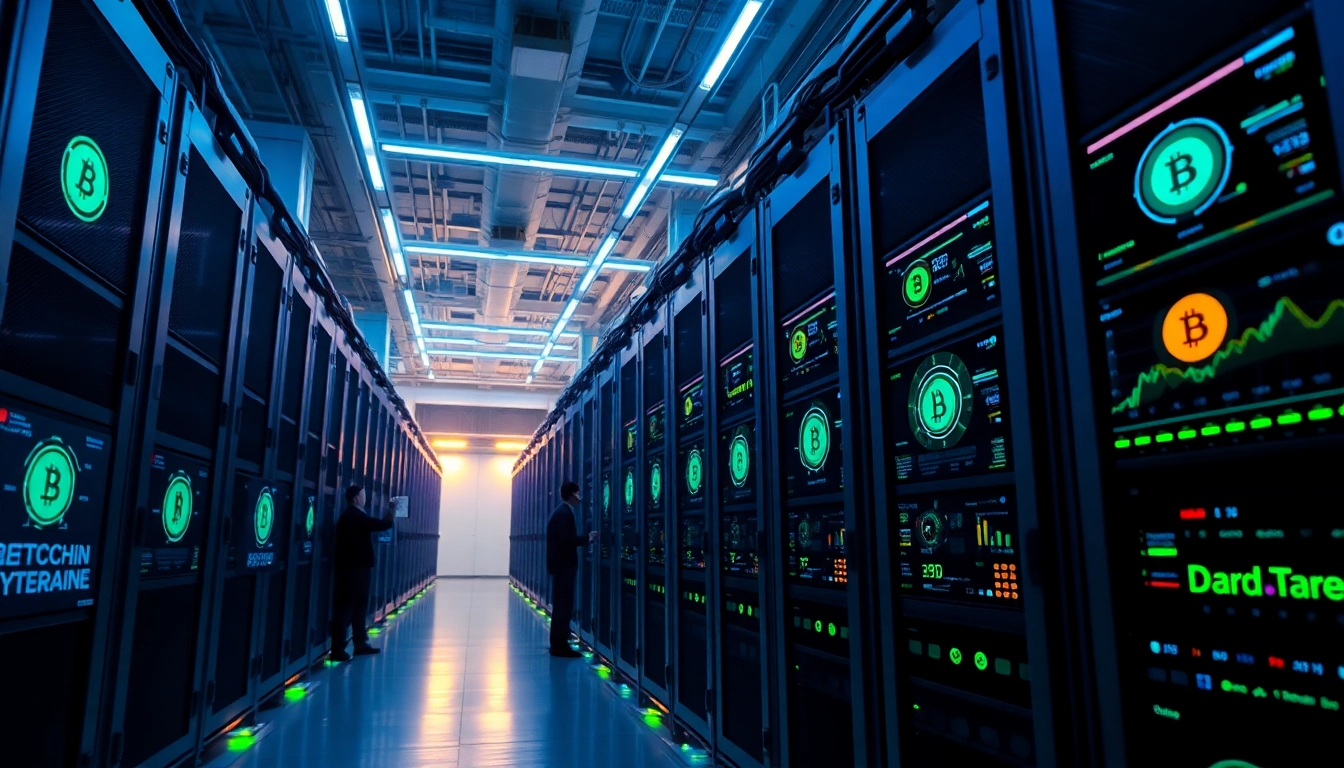Understanding Bitcoin Mining
What is Bitcoin Mining?
Bitcoin mining is the process through which new bitcoins are created and transactions are verified and added to the public ledger, known as the blockchain. Essentially, miners, using powerful computers, solve complex mathematical problems that validate these transactions. This process ensures that the Bitcoin network operates smoothly and securely. Miners are rewarded with newly minted bitcoins and transaction fees, incentivizing them to maintain the network’s integrity. To delve deeper into this fascinating aspect of cryptocurrency, you can explore Bitcoin mining and its overall impact on digital currencies.
The Bitcoin Mining Process Explained
The Bitcoin mining process consists of several steps that work in unison to ensure the successful operation of the network:
- Transaction Collection: Miners collect transactions from the Bitcoin network broadcast. These transactions need to be verified to ensure their legitimacy.
- Hash Generation: Miners use cryptographic algorithms to generate a hash. A hash is a fixed-length string derived from input data. The miner’s goal is to find a hash that is lower than a certain target set by the network, known as the difficulty level.
- Block Creation: Once a miner finds the correct hash, they create a new block that contains a collection of verified transactions. This block is then added to the blockchain, effectively recording those transactions permanently.
- Reward Collection: Upon successfully mining a block, the miner receives a reward of newly created bitcoins, and transaction fees from the included transactions.
Common Misconceptions About Bitcoin Mining
Despite its growing popularity, Bitcoin mining is often surrounded by various misconceptions. Here are a few clarifications:
- Bitcoin Mining is Profitable for Everyone: While it can be profitable, the level of investment in hardware, electricity, and maintenance can deter many individuals from profiting significantly.
- All Mining is the Same: There are different types of mining, including individual mining, pool mining, and cloud mining, each with its advantages and disadvantages.
- Bitcoin is Unlimited: Unlike fiat currencies, bitcoin is capped at 21 million coins. This limited supply is one of the reasons it has gained traction as a store of value.
Getting Started with Bitcoin Mining
Choosing the Right Mining Equipment
Getting started in Bitcoin mining begins with selecting the appropriate hardware. Here are the primary options:
- ASIC Miners: Application-Specific Integrated Circuits (ASICs) are purpose-built machines specifically designed for mining cryptocurrency, providing the best performance for energy cost.
- GPUs: Graphic Processing Units can be used for mining but are less efficient compared to ASIC miners. However, they allow for mining various cryptocurrencies, not just Bitcoin.
- Mining Rigs: A combination of GPUs can create a mining rig, offering flexibility but requiring significant setup and optimization.
Setting Up Your Bitcoin Mining Operation
Setting up a Bitcoin mining operation involves several key steps:
- Location: Choose a location with access to cheap electricity, stable internet, and good cooling conditions for hardware.
- Mining Software: Select the appropriate mining software based on your hardware. Popular options include CGMiner, BFGMiner, and EasyMiner.
- Configuration: Configure the software to connect to a mining pool if you opt for pool mining. This step enhances your chance of earning rewards.
Understanding Mining Pools and Their Benefits
Mining pools allow multiple miners to combine their computational resources to enhance their chances of successfully mining a block:
- Increased Chance of Rewards: By pooling resources, miners increase the likelihood of earning rewards, contributing to more consistent payouts.
- Reduced Variability: Rewards in mining pools are typically distributed based on the amount of computational power contributed, reducing unpredictability in earnings.
- Community Support: Joining a mining pool often provides access to a community of experienced miners who can offer assistance and advice.
Advanced Bitcoin Mining Techniques
Optimizing Mining Rigs for Better Performance
To maximize the effectiveness of your mining operation, here are some advanced optimization techniques:
- Overclocking: This technique involves running your hardware at speeds beyond its official specifications, increasing the hash rate. However, it also generates more heat and can potentially lead to hardware failure if not managed correctly.
- Efficient Cooling: Keeping your mining rigs cool will enhance their performance and longevity. Consider investing in additional cooling solutions, such as fans or liquid cooling systems.
- Software Optimization: Regularly update your mining software and tweak settings to extract the best performance from your rig.
Utilizing Cloud Mining Services
Cloud mining allows users to rent mining power without the need for hardware:
- Convenience: Cloud mining removes the need for managing hardware or electricity costs, allowing users to start mining quickly.
- Scalability: Cloud mining services provide options for scaling efforts without the immediate capital outlay associated with purchasing mining equipment.
- Risk Mitigation: By using cloud mining, participants can avoid the maintenance and operational risks associated with running hardware.
Strategies for Reducing Energy Costs
Given the significant energy consumption associated with Bitcoin mining, implementing strategies to reduce energy costs is crucial:
- Choosing Renewable Energy Sources: Miners can consider using renewable energy sources, such as solar or wind power, which can reduce costs and promote sustainability.
- Energy-Efficient Equipment: Investing in energy-efficient mining hardware can help lower electricity costs, allowing miners to maximize profits.
- Time-of-Use Pricing: Some energy companies offer different rates based on the time of day. Mining during off-peak hours can significantly lower costs.
Challenges in Bitcoin Mining
Regulatory Issues Surrounding Bitcoin Mining
Bitcoin mining faces various regulatory challenges worldwide:
- Legal Uncertainty: Different countries have diverse regulations governing cryptocurrency, which can impact mining operations and profitability.
- Licensing and Compliance: Some jurisdictions require licenses to operate mining facilities, necessitating adherence to local laws to avoid penalties.
- Tax Implications: Miners often face taxation on their earnings and need to maintain detailed records of transactions for regulatory compliance.
Addressing Environmental Concerns
As Bitcoin mining continues to grow, its environmental footprint is a critical conversation:
- High Energy Consumption: The energy needed for Bitcoin mining has raised concerns about its environmental impact, especially in regions reliant on fossil fuels.
- Carbon Footprint: Miners often face scrutiny regarding their carbon footprint, urging the need for greener alternatives and technology.
- Sustainable Practices: Many miners are now implementing sustainable practices, such as using renewable energy and adhering to eco-friendly regulations.
Dealing with Market Volatility
Bitcoin’s price volatility presents a significant challenge for miners:
- Profitability Fluctuations: Changes in Bitcoin prices directly impact the profitability of mining operations, which can lead to heightened uncertainty.
- Market Analysis: Staying informed about market trends and potential price movements is essential for miners to make strategic decisions.
- Long-Term Strategy: Developing a long-term mining strategy that accounts for market fluctuations can help sustain operations during downturns.
Future of Bitcoin Mining
The Impact of Technology on Bitcoin Mining
Technological advancements continue to shape the landscape of Bitcoin mining:
- Improved Algorithms: The development of more efficient mining algorithms can enhance performance while lowering energy consumption.
- Integration with AI: The integration of artificial intelligence can optimize mining operations further, making them more efficient and cost-effective.
- Quantum Computing: While still in its infancy, advancements in quantum computing could revolutionize mining capabilities, presenting both opportunities and challenges.
What’s Next for Bitcoin Miners?
The future for Bitcoin miners is complex, with several trends expected to influence the industry:
- Continued Regulation: As governments worldwide move to regulate cryptocurrencies, miners must adapt to ensure compliance.
- Shift to Decentralization: Emphasis on decentralization may lead to new models of mining that reduce reliance on large mining pools and enhance security.
- Investment in Sustainable Practices: As environmental concerns grow, miners will likely invest more in sustainable practices and infrastructure.
Emerging Trends in Cryptocurrency Mining
Several emerging trends are poised to impact cryptocurrency mining:
- Increase in Mining Diversification: Miners are beginning to explore alternative cryptocurrencies as Bitcoin’s mining difficulty increases.
- Rise of Decentralized Finance (DeFi): Opportunities within DeFi can provide new avenues and revenue streams for miners, enhancing their resilience.
- Community Mining Initiatives: Grassroots initiatives promoting community mining can foster collaboration and knowledge sharing among miners.



